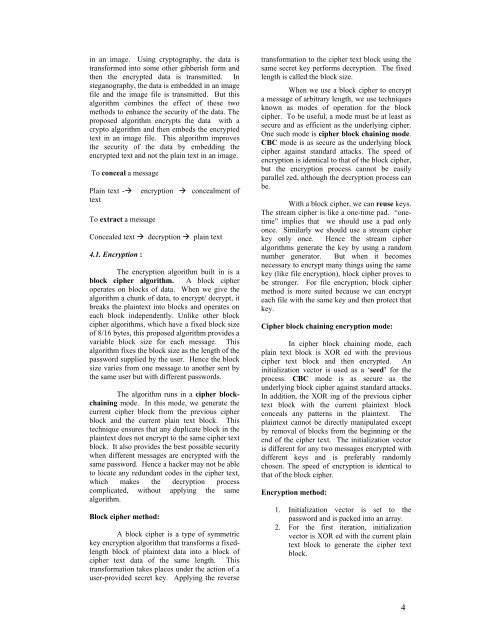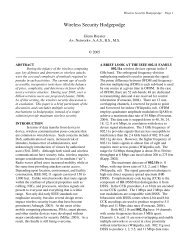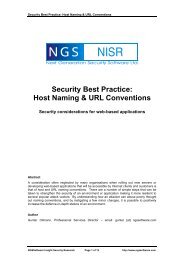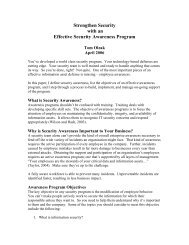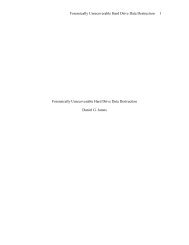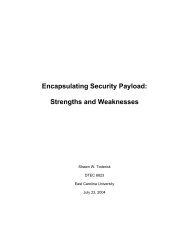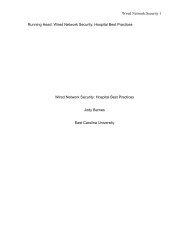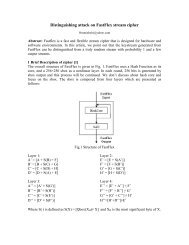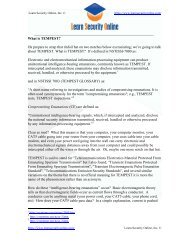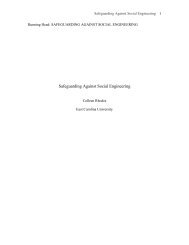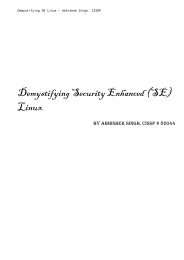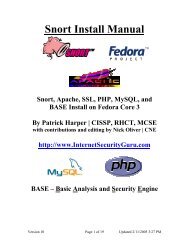Data security through obscurity - Rootsecure.net
Data security through obscurity - Rootsecure.net
Data security through obscurity - Rootsecure.net
Create successful ePaper yourself
Turn your PDF publications into a flip-book with our unique Google optimized e-Paper software.
in an image. Using cryptography, the data is<br />
transformed into some other gibberish form and<br />
then the encrypted data is transmitted. In<br />
steganography, the data is embedded in an image<br />
file and the image file is transmitted. But this<br />
algorithm combines the effect of these two<br />
methods to enhance the <strong>security</strong> of the data. The<br />
proposed algorithm encrypts the data with a<br />
crypto algorithm and then embeds the encrypted<br />
text in an image file. This algorithm improves<br />
the <strong>security</strong> of the data by embedding the<br />
encrypted text and not the plain text in an image.<br />
To conceal a message<br />
Plain text - encryption concealment of<br />
text<br />
To extract a message<br />
Concealed text decryption plain text<br />
4.1. Encryption :<br />
The encryption algorithm built in is a<br />
block cipher algorithm. A block cipher<br />
operates on blocks of data. When we give the<br />
algorithm a chunk of data, to encrypt/ decrypt, it<br />
breaks the plaintext into blocks and operates on<br />
each block independently. Unlike other block<br />
cipher algorithms, which have a fixed block size<br />
of 8/16 bytes, this proposed algorithm provides a<br />
variable block size for each message. This<br />
algorithm fixes the block size as the length of the<br />
password supplied by the user. Hence the block<br />
size varies from one message to another sent by<br />
the same user but with different passwords.<br />
The algorithm runs in a cipher blockchaining<br />
mode. In this mode, we generate the<br />
current cipher block from the previous cipher<br />
block and the current plain text block. This<br />
technique ensures that any duplicate block in the<br />
plaintext does not encrypt to the same cipher text<br />
block. It also provides the best possible <strong>security</strong><br />
when different messages are encrypted with the<br />
same password. Hence a hacker may not be able<br />
to locate any redundant codes in the cipher text,<br />
which makes the decryption process<br />
complicated, without applying the same<br />
algorithm.<br />
Block cipher method:<br />
A block cipher is a type of symmetric<br />
key encryption algorithm that transforms a fixedlength<br />
block of plaintext data into a block of<br />
cipher text data of the same length. This<br />
transformation takes places under the action of a<br />
user-provided secret key. Applying the reverse<br />
transformation to the cipher text block using the<br />
same secret key performs decryption. The fixed<br />
length is called the block size.<br />
When we use a block cipher to encrypt<br />
a message of arbitrary length, we use techniques<br />
known as modes of operation for the block<br />
cipher. To be useful, a mode must be at least as<br />
secure and as efficient as the underlying cipher.<br />
One such mode is cipher block chaining mode.<br />
CBC mode is as secure as the underlying block<br />
cipher against standard attacks. The speed of<br />
encryption is identical to that of the block cipher,<br />
but the encryption process cannot be easily<br />
parallel zed, although the decryption process can<br />
be.<br />
With a block cipher, we can reuse keys.<br />
The stream cipher is like a one-time pad. “o<strong>net</strong>ime”<br />
implies that we should use a pad only<br />
once. Similarly we should use a stream cipher<br />
key only once. Hence the stream cipher<br />
algorithms generate the key by using a random<br />
number generator. But when it becomes<br />
necessary to encrypt many things using the same<br />
key (like file encryption), block cipher proves to<br />
be stronger. For file encryption, block cipher<br />
method is more suited because we can encrypt<br />
each file with the same key and then protect that<br />
key.<br />
Cipher block chaining encryption mode:<br />
In cipher block chaining mode, each<br />
plain text block is XOR ed with the previous<br />
cipher text block and then encrypted. An<br />
initialization vector is used as a ‘seed’ for the<br />
process. CBC mode is as secure as the<br />
underlying block cipher against standard attacks.<br />
In addition, the XOR ing of the previous cipher<br />
text block with the current plaintext block<br />
conceals any patterns in the plaintext. The<br />
plaintext cannot be directly manipulated except<br />
by removal of blocks from the beginning or the<br />
end of the cipher text. The initialization vector<br />
is different for any two messages encrypted with<br />
different keys and is preferably randomly<br />
chosen. The speed of encryption is identical to<br />
that of the block cipher.<br />
Encryption method:<br />
1. Initialization vector is set to the<br />
password and is packed into an array.<br />
2. For the first iteration, initialization<br />
vector is XOR ed with the current plain<br />
text block to generate the cipher text<br />
block.<br />
4


